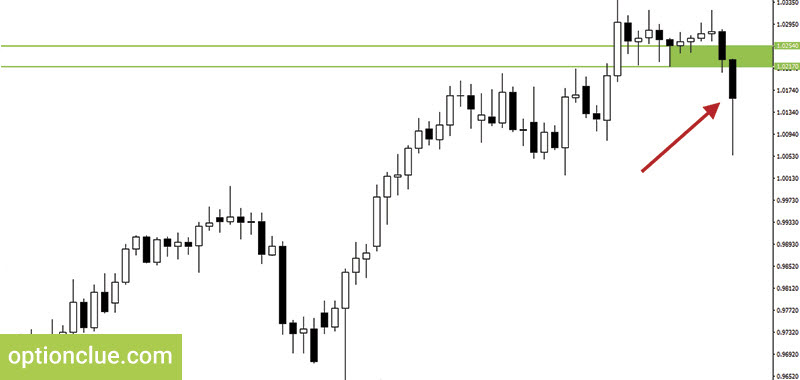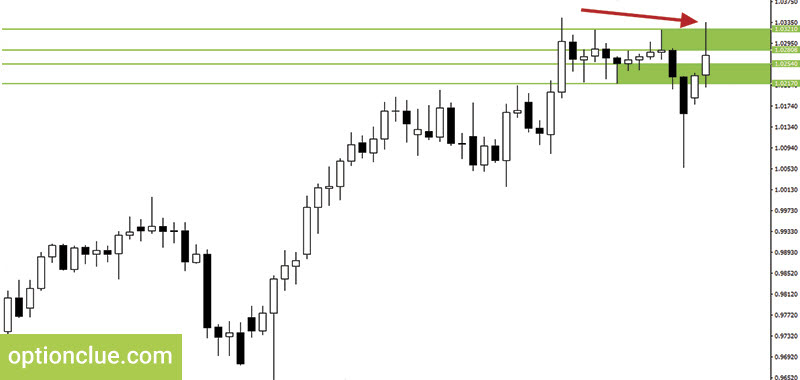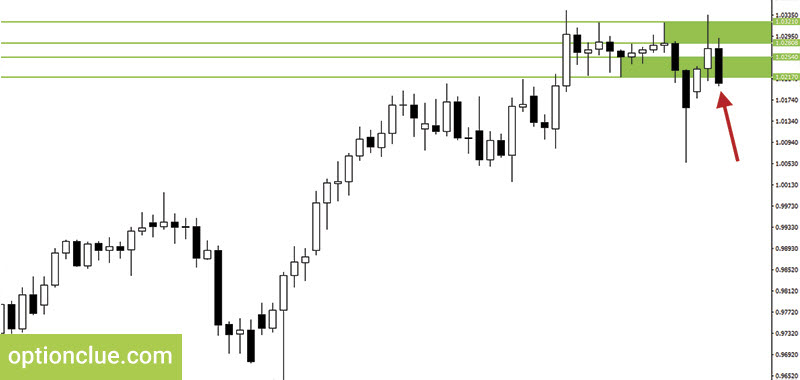Trading tactics. Breakout trading and pullback trading

In this article we’ll talk about how the market moves after the level breakout.
Contents
Preparations for the market entry point
Let’s analyze the Daily timeframe of the USDCHF currency pair. The closest support is a classic level, plotted on two bear and two bull candles. Its lower border is 1.0217 and can be placed by the shadow of the candle, which is involved in the price reversal at this point, the upper border is 1.0254. We paint out this level with a rectangle to understand how the market reacts to it (Figure 1).
Example of a breakout trading
The price was rising for some time and then it tested the resistance level again, and then was declining for 2 days. After the candle closing on the 30th there was the support level breakout and a bearish signal (a breakout signal) was generated.
You can see that the body of the bear candle is closed much below the support level. In such situations, we can confidently say there was a level breakout. The price set to close lower and whereupon sell positions may be relevant (Figure 2).
The first trading tactics that is efficient in such situations is opening a position after the breakout candle closing, i.e. it is the breakout level trading. The second option is to trade a pullback after the correction is completed.
Let’s see what happens next. The market is in correction for 2 days. In most cases trends evolve non-linearly, price growth or decline in each period will correspond to the market correction.
This occurs due to the fact that as the price moves, the balance between buyers and sellers shifts, that’s why after each impulse wave corrections are formed. These are movements against the trend.
Over the next 2 days the market is in correction, moreover, the price tests the resistance level (Figure 3) – the market is again about 15 points above it. Someone has opened long positions, apparently, waiting for a breakout.
Pullback trading example
At the same time the correction is over and the market continues to decline in the direction of the main trend. Here, after the candle is closed on January the 4th, the bear trend has been confirmed, and the pullback trading signal from the level has been formed (Figure 4).
This trend allowed to enter the market both those traders who prefer opening a breakout positions and those who prefer trading after the correction completion by opening a pullback position.
The market further continues to decline non-linearly, the fall periods alternate with the periods of sufficiently deep corrections, approximately 50-60% of the impulse wavelength. Afterwards there is a fall again, the support level is updated and is new in this movement.
For the whole month the bear trend evolved in the market of the USDCHF currency pair (Figure 5).
Afterwards, the price begins to rise, the trend reversal occurs after the candle has been closed on February the 9th. The resistance level is formed whereupon it has been broken. After this candle closing the trend direction has changed and the bullish positions become relevant (Figure 6).
Let’s summarize. You should always focus on the fact of a level breakout by the price, wait for the market closing. In this case you will be able to say confidently what trend is in the market now, this trend continues or reverses.
If you trade on small timeframes, the situation will be somewhat different, since more information is needed here. Anyway, I recommend you to trade always with an eye on the large timeframes, on which the prevailing market trends are formed.
Traders often make the process of plotting horizontal support and resistance levels much more difficult than it needs to be. Some of them tend to complicate this task by plotting unnecessary levels confusing them in determining further price movements in directed trading. After getting the Levels indicator you won’t have any difficulty in this due to the simplicity of its use. It can help not only identify price zones where the market movement can slow down or price reversal is likely to occur but also find entry signals that appear during a deep market correction or calculate stop-loss and take-profit.
Also read more about breakout trading strategy. Good luck in trading!






